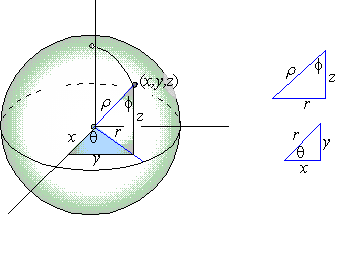Triple Integrals in Spherical Coordinates
Suppose now that S is a solid bounded in spherical coordinates
by q = a, q = b, f = p( q) , f = q( q) , r = f( f,q) , and r = g( f,q) , and recall that in spherical
coordinates, the variables z and r are related to r and f by
| r2+z2 |
= |
r2 |
| r |
= |
r sin(f) |
| z |
= |
r cos(f) |
|
|
 |
|
That is, r,f are the ''polar'' coordinates for the zr-plane. Since in the xy-plane,
the differential is dy dx = r dr dq, so also in the zr-plane, the differential is
Thus, r dz dr dq becomes rr drdf dq, so that (1) becomes
|
|
ó
õ
|
|
ó
õ
|
|
ó
õ
|
S
|
U( x,y,z) dV = |
ó
õ
|
b
a
|
|
ó
õ
|
q( q)
p( q)
|
|
ó
õ
|
g( f,q)
f( f,q)
|
U( rcosq,rsin( q) ,rcos( f) ) rr drdf dq |
| (2) |
where r = rsin( f) . Although (2) is a quite useful tool
for converting triple integrals into spherical coordinates, it is customary
to use r = rsin( f) to eliminate r, thus producing
the formula for change of variable into spherical coordinates
|
|
ó
õ
|
|
ó
õ
|
|
ó
õ
|
S
|
U( x,y,z) dV = |
ó
õ
|
b
a
|
|
ó
õ
|
q( q)
p( q)
|
|
ó
õ
|
g( f,q)
f( f,q)
|
U( r,f,q) r2sin( f) drdfdq |
|
where U( r,f,q) = U( r sin(f) cos(q), r sin(f) sin(q), rcos(f) ) .
In particular, remember that in spherical coordinates, the volume
differential is given by either
|
dV = rr dr df dq or dV = r2 sin(f) dr df dq |
|
Moreover, remember also the relationships given by the two right triangles
relating ( x,y,z) to ( r,f,q) . (See the figure above). In particular, x2+y2 = r2 implies x2+y2 = r2sin2( f) and r2+z2 = r2 implies that
Also remember that q ranges over [ 0,p] , while f ranges over [ 0,p] .
EXAMPLE 2 Use spherical coordinates to evaluate the triple
integral
Solution: To begin with, we notice that this iterated integral
reduces to
As a result, in spherical coordinates it becomes
|
|
ó
õ
|
2p
0
|
|
ó
õ
|
p
0
|
|
ó
õ
|
1
0
|
|
|
r2sin( f) dr df dq |
|
since x2+y2+z2 = r2. Thus, we have
|
|
ó
õ
|
2p
0
|
|
ó
õ
|
p
0
|
|
ó
õ
|
1
0
|
r3 sin(f) dr df dq |
|
|
|
|
ó
õ
|
2p
0
|
|
ó
õ
|
p
0
|
|
ó
õ
|
1
0
|
r3sin( f) dr df dq |
| |
|
|
|
ó
õ
|
2p
0
|
|
ó
õ
|
p
0
|
|
r4
4
|
ê
ê
|
1
0
|
sin( f) dfdq |
| |
|
|
|
1
4
|
|
ó
õ
|
2p
0
|
|
ó
õ
|
p
0
|
sin( f) dfdq |
| |
|
|
|
1
4
|
|
ó
õ
|
2p
0
|
-cos( f) |
ê
ê
|
p
0
|
dq |
| |
|
|
|
EXAMPLE 3 Find the volume of the solid above the cone z2 = x2+y2 and below the plane z = 1.
Solution: The cone z2 = x2+y2 corresponds to f = p/4
in spherical.
Moreover, z = 1 corresponds to rcos( f) = 1, or r = sec( f) . Thus,
|
|
|
|
|
ó
õ
|
2p
0
|
|
ó
õ
|
p/4
0
|
|
ó
õ
|
sec( f)
0
|
r2sin( f) drdfdq |
| |
|
|
|
ó
õ
|
2p
0
|
|
ó
õ
|
p/4
0
|
|
r3
3
|
ê
ê
|
sec( f)
0
|
sin( f) dfdq |
| |
|
|
1
3
|
|
ó
õ
|
2p
0
|
|
ó
õ
|
p/4
0
|
sec3( f)sin( f) dfdq |
|
|
However, sec( f) sin( f) = tan(f) , so that
|
V = |
1
3
|
|
ó
õ
|
2p
0
|
|
ó
õ
|
p/4
0
|
tan( f) sec2( f) dfdq |
|
Thus, u = tan( f) , du = sec2( f) df, u( 0) = tan( 0) = 0 and u( p/4) = tan( p/4) = 1 yields
Check your Reading: Why does the cone z2 = x2+y2
correspond to f = p/4?
